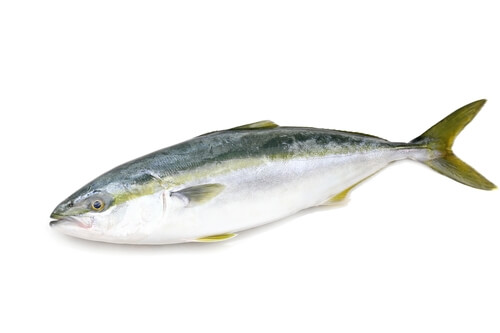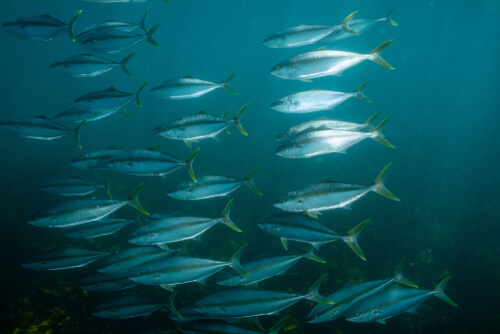
| Kingdom | Animalia |
| Phylum | Chordata |
| Class | Actinopterygii |
| Order | Carangiformes |
| Family | Carangidae |
| Genus | Seriola |
| Species | S. lalandi |
| Niche | Secondary consumer |
| Length | Up to 98 in (250 cm) |
| Weight | Up to 80 lb (37 kg) |
| Lifespan | 5-6 years (12 maximum) |
| Social Structure | Solitary or schooling (age-dependent) |
| Conservation Status | Least Concern |
| Preferred Habitat | Nearshore marine waters (tropical, subtropical, temperate) |
| Average Clutch Size | 100-150 |
| Main Food Items and Prey | Herring, sardines, anchovies, flying fish, squid |
| Predators | Large tuna and billfish, toothed whales, sharks, sea lions, seals |
The Basics
The yellowtail is a medium-sized fish that occurs throughout the Pacific and Atlantic oceans in tropical to temperate waters. Also commonly referred to as the yellowtail amberjack, it is one of nine members of the genus Seriola collectively referred to as amberjacks.
Description
The yellowtail has a long, fusiform body, and can grow to about 7 feet in length with a weight of up to 80 pounds or more. Their upper dorsal sides are blue with a silvery-white color on their belly and lower flanks. They also have a thin bronze-colored stripe down the middle of their bodies. Near their tail this transitions to a yellow color, which is also the color of their fins, of which there are 6.

Some of these fins contain spines, including their anterior dorsal fin which has approximately 7-8. The posterior dorsal fin has one spine and up to 35 rays while their anal fin has up to 3 spines and 22 rays. Their caudal or tail fin is thin at its base and is relatively large, while the pectoral fins are particularly short.
Distribution and Habitat
Little is known about the species’ biology and migratory patterns. Previously, it was thought that S. lalandi occurred in all of the world’s oceans. However, recent analysis suggests that the southern populations may be distinct from those occurring in the northern hemisphere. This would make them a distinct but very similar species. S. lalandi is also thought to occur in northern waters at certain times during the year as well. In general, they prefer tropical or subtropical waters and are occasionally found in mild temperate regions as well.
All yellowtail are pelagic, schooling fish. Young fish will spend their time in large schools while older fish sometimes school a little less densely and in fewer numbers. They spend most of their time relatively near the coast and rocky reefs. Typically they are found near the surface, in waters up to about 150 feet deep. Adult fish will also be found near offshore seamounts and islands as well.
Diet and Predators
The yellowtail amberjack is a predator, using its speed to ambush prey when provided the opportunity. They favor various small fish species such as sardines, herring, and anchovies. They will also hunt squid, particularly at night when they and other creatures emerge from the depths to inhabit surface waters under the cover of darkness.

In turn, the yellowtail is on the menu for a wide variety of marine predators. Marine mammals such as sea lions and seals will eat almost any fish they come across, while toothed whales such as the orca will also likely hunt yellowtail and many similar species. The great white shark and other larger species such as the mako shark will also hunt the yellowtail, in addition to larger species of fish such as bluefin tuna and various billfishes such as marlin. Humans also like to catch the species, as it is a common target of both commercial and sport fisheries throughout its range.
Reproduction and Life Cycle
Relatively is little known about the reproductive behavior of yellowtail. They are broadcast spawners, with males and females releasing their gametes into the water column where external fertilization occurs. During the spawning season, which occurs throughout the summer, females may release up to 150 eggs at a time, approximately 100 of which are likely to be fertilized. Younger females will spawn only once while older individuals are capable of spawning multiple times in a season.
Young yellowtails will become sexually mature at about 2-3 years of age while most individuals live for 5-6 years. However, a maximum lifespan of approximately 12 years has been observed in captivity.
Conservation Status
With widespread distribution and relatively healthy populations, the yellowtail amberjack is listed as Least Concern on the IUCN Red List of Threatened Species.
Fun Facts about the Yellowtail!
The yellowtail forms an important commercial and sport fishery throughout its range. It is also a unique candidate for aquaculture operations and remains a bit of a taxonomic point of contention. Indeed, it is a fascinating species that allows for the exploration of several interesting biological insights.
Sustainably Grown
While the human population grows it continues to put an increasing amount of pressure on ecosystems around the world. This is especially true in the oceans, where up to 90% of the biggest fish in the sea are already gone, a victim of overfishing. Because of this, there is an ever-increasing interest in establishing sustainable aquaculture practices.

However, in some cases such as the farming of Atlantic salmon in coastal British Columbia, the environmental harm may be even larger than the fishery itself. Because salmon require sea-based pens to be successfully grown, there is more interaction than desired between the fish farms and the natural environment.
Some species, however, can be farmed on land in large tanks and other similar systems. The yellowtail is one such species and has been cultivated this way in several countries already, including New Zealand, Chile, and the USA. However, due to the lack of understanding of the species’ biology and lifecycle, it is difficult to catch wild juvenile stock. Instead, these operations rely on hatcheries to receive a captively bred stock of juveniles. Despite these challenges, the yellowtail appears to be a strong candidate to be farmed sustainably and in an environmentally friendly way.
Not Quite Settled
Although most authorities currently recognize populations very similar to Seriola lalandi in the northern hemisphere as of the same species, others contest that there are two additional species. Under this taxonomic regime, yellowtail occurring in the North Pacific Ocean to Japan are considered Seriola aureovittata while those occurring in the northeastern Pacific such as California and Mexico are considered Seriola dorsalis. This distinction recognizes the fact that for the most part, the yellowtail amberjack is a species that occurs in the southern hemisphere. However, in some areas during certain seasons, a very similar fish occurs in northern waters, giving rise to the feud over whether or not these are simply populations of the same species or distinct species altogether.

Camo-Fish
Like many other pelagic marine species, the yellowtail is darker on its dorsal side than on its silvery-white lower flanks and ventral side. This blue and silvery coloring acts as a camouflage for the fish via a phenomenon known as countershading. This is observed in many other species including sharks and other fish. In fact, this phenomenon can be observed throughout the animal kingdom.
When diffuse light falls on an object – or an animal – from above it casts light unevenly across its surface. For a uniformly colored object, this causes the illuminated top side to appear brighter to the observer than the shaded underside, making the object conspicuous.
In nature, being conspicuous is rarely an advantage, as it allows animals to be seen by their potential predators and vice versa. In the most classic version of countershading, these two-toned animals are able to counteract this physical phenomenon of light and shadows, allowing them to blend into their environment better than they would if uniformly colored.
